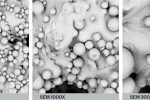3DPRINTINGINDUSTRY.COM
Himed Compares Abrasives for 3D Printed Implants
Himed LLC, a biomaterials company specializing in titanium surface treatments, has published new findings comparing abrasive blasting methods for post-processing 3D printed medical implants. The company evaluated aluminum oxide, glass bead, and apatitic abrasives on 3D printed Ti64 spinal spacers, assessing each method’s ability to remove residual build material while preserving a biocompatible surface. Only the apatitic abrasive, a calcium phosphate-based medium, left behind a clean titanium surface after ASTM F86 passivation.
Additively manufactured titanium implants frequently retain loosely bound spherical particles on both external and internal surfaces. These residual beads, which result from the 3D printing process, are visible under scanning electron microscopy and can remain lodged in porous lattice structures. If left untreated, they pose a risk of detachment during packaging or after implantation. Surface finishing is therefore required to eliminate this debris while preserving implant geometry and optimizing the surface for osseointegration.
SEM imagery of a 3d printed Ti64 spinal spacer following abrasive blasting with aluminum oxide grit. Photo via Himed, LLC.
SEM and energy-dispersive X-ray spectroscopy (EDX) analysis conducted by Himed revealed that both aluminum oxide and glass bead blasting remove residual titanium beads but introduce new contaminants. Due to its high hardness rating of 9 on the Mohs scale, aluminum oxide embeds into the titanium surface during application. These abrasive remnants cannot be removed using ultrasonic cleaning or acid baths. Glass bead blasting, while less aggressive, also results in silica-based particulates embedded in the implant surface. EDX spectra confirmed that both methods alter the surface composition of titanium implants, raising concerns about long-term biological compatibility.
A 2019 literature review published in JMIR Biomedical Engineering noted that implant surface roughness plays a significant role in bone-to-implant contact (BIC) and mechanical fixation. Techniques such as grit blasting and acid etching have been shown to improve osseointegration by creating micro- and nanoscale textures that encourage osteoblast activity. However, the review also emphasized that inconsistencies in surface chemistry—such as those introduced by embedded blasting media—could compromise outcomes. Biocompatible materials like calcium phosphates were identified as favorable for surface modification due to their resorbability and osteoconductive properties.
SEM imagery of a 3D printed Ti64 spinal spacer following abrasive blasting with aluminum oxide grit. Photo via Himed, LLC.
Himed’s apatitic abrasive, marketed as MATRIX MCD, is composed of hydroxyapatite and tricalcium phosphate. Designed to be fully soluble, it leaves no trace residue after passivation. Originally developed for use on dental implants prior to hydroxyapatite coating, the abrasive is now applied to 3D printed orthopedic components. Available in particle sizes down to <53 μm, MATRIX MCD is able to reach internal cavities in porous implants and create a uniform surface texture. SEM imaging of titanium spinal spacers processed with this material shows consistent roughness on both exterior and internal surfaces, with no embedded contaminants detected following ASTM F86 treatment.
Adjustments to particle size, blast pressure, and duration allow control over the resulting surface roughness, which ranged between 1.0 and 3.2 μm Ra in the study. This roughness range aligns with published targets for promoting cell adhesion and tissue integration. Unlike harder abrasives, the calcium phosphate formulation refines the surface without altering the implant’s geometry or critical tolerances. Post-processing with MATRIX MCD preserved the original design features while eliminating bead residue and avoiding secondary contamination, according to EDX scans.
SEM sequence demonstrating the post-passivation results of a MATRIX MCD. Photo via Himed, LLC.
Himed has spent three decades refining the production and application of MCD apatitic abrasives across dental and orthopedic markets. With the increased use of lattice-based designs in 3D printed implants, the ability to remove build residue without compromising biocompatibility or surface purity is becoming a critical requirement for medical device manufacturers.
Ready to discover who won the 20243D Printing Industry Awards?
Subscribe to the 3D Printing Industry newsletter to stay updated with the latest news and insights.
Featured image showcase SEM imagery of a 3d printed Ti64 spinal spacer following abrasive blasting with aluminum oxide grit. Photo via Himed, LLC.
Anyer Tenorio Lara
Anyer Tenorio Lara is an emerging tech journalist passionate about uncovering the latest advances in technology and innovation. With a sharp eye for detail and a talent for storytelling, Anyer has quickly made a name for himself in the tech community. Anyer's articles aim to make complex subjects accessible and engaging for a broad audience. In addition to his writing, Anyer enjoys participating in industry events and discussions, eager to learn and share knowledge in the dynamic world of technology.
